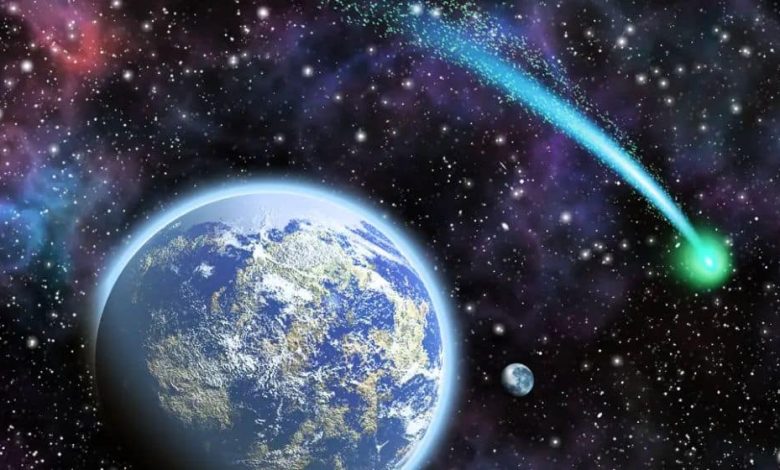
What is a comet?
Devil Comets are celestial bodies composed of ice, dust, and rock that originate from the outer regions of our solar system. These icy wanderers are often referred to as “dirty snowballs” due to their composition. As comets approach the sun, the heat causes the ice to vaporize, creating a glowing coma or atmosphere around the nucleus. This coma can extend for thousands of miles and is often accompanied by a bright tail that points away from the sun.
Comets have fascinated astronomers and skywatchers for centuries. They are remnants from the early formation of our solar system and contain valuable clues about its origins. Studying comets provides insights into the chemical makeup of the universe and the processes that led to the creation of planets and other celestial objects. The Devil Comet, with its impending visit to Earth, presents an exciting opportunity to delve deeper into the mysteries of these captivating cosmic entities.
The discovery of the Devil Comet
The Devil Comet, officially designated as C/2022 T1, was first discovered by a team of astronomers at the Mount Lemmon Observatory in Arizona. Its ominous nickname was given due to its eerie appearance and the timing of its close approach to Earth. While the moniker may sound intimidating, it is important to remember that it is purely symbolic and has no scientific basis. The Devil Comet is simply a fascinating object of study for astronomers and enthusiasts alike.
Characteristics of the Devil Comet
The Devil Comet is estimated to have a nucleus diameter of around 5 kilometers, making it a relatively large comet. Its size, combined with its close proximity to Earth, ensures that it will be visible to the naked eye, providing a rare opportunity for skywatchers to witness its beauty. As the comet approaches the sun, the heat will cause its icy nucleus to vaporize, creating a luminous coma and a distinctive tail that will add to its visual allure.
Comets like the Devil Comet are believed to originate from the Oort Cloud, a vast region located at the outermost edge of our solar system. Their elongated orbits bring them closer to the sun periodically, allowing us to catch a glimpse of their majestic displays. These celestial visitors are a reminder of the vastness and diversity of our universe.
The orbit of the Devil Comet
The Devil Comet follows a highly elongated orbit around the sun. Its trajectory takes it from the outer reaches of our solar system to a point close to our planet. However, despite its proximity, there is no cause for alarm. Scientists have meticulously calculated the orbit of the Devil Comet, ensuring that it will pass by Earth at a safe distance. This fascinating celestial event poses no threat to our planet or its inhabitants.
Potential impact of the Devil Comet
Comets have been associated with fear and cataclysm throughout history. Their sudden appearances in the night sky have often been interpreted as omens of doom. However, modern scientific understanding allows us to dismiss these fears. The Devil Comet’s trajectory has been carefully studied, and astronomers can confidently assert that it will pass by our planet harmlessly.
In fact, the close encounter with the Devil Comet provides a unique opportunity for scientists to study comets up close. Space agencies, such as NASA, are planning missions to rendezvous with comets and gather valuable data about their composition and structure. These missions will shed light on the origins of our solar system and potentially help us understand the processes that led to the formation of life on Earth.
NASA’s monitoring and tracking of the Devil Comet
NASA, the United States’ premier space agency, has been closely monitoring the path of the Devil Comet. The agency’s scientists and astronomers are using a combination of ground-based telescopes and space-based observatories to track the comet’s trajectory and gather valuable data. By studying the Devil Comet, NASA hopes to gain insights into the composition, structure, and behavior of comets in general.
The information gathered from this monitoring effort will contribute to our understanding of the universe and aid in the development of plans for future space missions. NASA’s efforts to study comets are part of a broader mission to explore and unravel the mysteries of our celestial neighborhood.
The scientific significance of studying comets
Comets, including the Devil Comet, play a crucial role in our understanding of the universe. They are considered time capsules that preserve the pristine materials from which our solar system formed billions of years ago. By analyzing the composition of comets, scientists can gain insights into the chemical processes that occurred during the early stages of our solar system’s development.
Comets are also believed to have delivered water and organic molecules to Earth, potentially contributing to the emergence of life. Studying comets provides a window into the conditions that existed when life on our planet was in its infancy. The Devil Comet, with its size and proximity, presents a unique opportunity to explore these questions and unlock the secrets of our cosmic origins.
Mythology and folklore surrounding comets
Throughout history, comets have captured the human imagination and have been the subject of various myths and folklore. These celestial visitors have been seen as harbingers of change, omens of disaster, and even messengers from the gods. Their sudden appearances and distinctive tails have sparked awe, fear, and wonder in cultures around the world.
In ancient times, comets were often associated with significant events and were believed to hold mystical powers. They were seen as celestial messengers or markers of divine intervention. These beliefs have evolved over time, but the fascination with comets and their symbolic significance remains.
Conclusion: The Devil Comet and its place in astronomical research
As the Devil Comet approaches our planet, it offers a rare opportunity to witness a celestial spectacle. This cosmic visitor, despite its ominous nickname, poses no threat to Earth. Instead, it presents scientists, astronomers, and skywatchers with a chance to explore the mysteries of our universe.
The Devil Comet’s close encounter allows us to study comets up close, unraveling the secrets of our solar system’s formation and potentially shedding light on the origins of life on Earth. Its journey through our night skies serves as a reminder of the vastness and beauty of our universe.
So, mark your calendars and prepare to be enthralled as the Devil Comet graces our night skies. This captivating celestial event is sure to leave you in awe and inspire a deeper appreciation for the wonders of our cosmos. Don’t miss this once-in-a-lifetime opportunity to witness the Devil Comet and join the ongoing quest to unlock the secrets of our universe.



